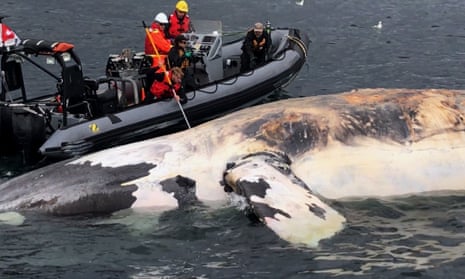Seven north Atlantic right whales have been found floating lifelessly in the Gulf of St Lawrence, off Canada, in recent weeks, in what is being described as a “catastrophic” blow to one of the world’s most endangered whales.
The first whale carcass was reported in early June. Within a month, another six reports came in, leaving marine biologists in the region reeling.
“It’s devastating,” said Tonya Wimmer of the Marine Animal Response Society, a charitable organisation dedicated to marine mammal conservation in the region. “This is, I think, the largest die-off they’ve ever had for this particularly species, at once.”
The global population of north Atlantic right whales – which live along the eastern seaboard of Canada and the US and can reach up to 16 metres (50ft) in length – is thought to be around 525, meaning that more than 1% of the population has died in the past month. “So it is catastrophic in terms of potential impact to this population.”

At least two of the whales were female, with one of them known to be entering its reproductive years. “You’re talking anywhere from five to 10 babies in their lifetime. And now they won’t happen. It’s heartbreaking,” said Wimmer.
With no obvious causes for the deaths, a team including federal scientists, pathologists and veterinarians have been racing against time to figure out what is happening. Last week they carried out necropsies on three of the whales, hoping to find clues before the carcasses decompose.
While their findings are still preliminary, they found signs of severe blunt trauma and bruising on two of the whales, suggesting collision with a vessel, while the third had been tangled in fishing gear for weeks.
The findings still don’t explain why the deaths have seemingly occurred within such a short time frame, said Wimmer, though “regardless, there are some aspects of the last stages of their life that were impacted by human activities in that area”. As scientists move into the laboratory to carry out further analyses, some have speculated that the deaths may have been caused by toxic algae or something the whales ate.

The north Atlantic right whale has struggled since being nearly hunted to extinction by whalers in the late 18th century. In recent years, researchers have noticed the whales moving into the Gulf of St Lawrence in large numbers, leading to increased interactions with humans.
Earlier this week, reports came in of a right whale in the area that was tangled in fishing gear. Some six hours after it was first spotted, scientists were able to cut the whale free of a fishing line in its mouth.
The entanglement, along with the unprecedented number of deaths, may suggest that fishing gear needs to be set out differently or that vessels need to start moving more slowly through the region, said Wimmer. “Right now there’s still a lot of questions,” she added. “There’s probably more questions than there are answers.”

Comments (…)
Sign in or create your Guardian account to join the discussion